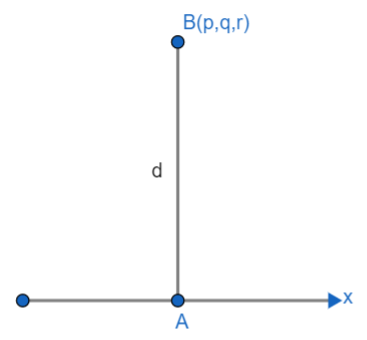
What is the distance of the point (p,q,r) from the x-axis?
Answer
561k+ views
Hint: In this question, we need to find the distance of the point (p,q,r) from the x axis. For this, we will evaluate the point on the x axis which is perpendicular to (p,q,r) and then find the distance between two points obtained. Distance between two points $\left( {{x}_{1}},{{y}_{1}},{{z}_{1}} \right)\text{ and }\left( {{x}_{2}},{{y}_{2}},{{z}_{2}} \right)$ is given by \[\sqrt{{{\left( {{x}_{2}}-{{x}_{1}} \right)}^{2}}+{{\left( {{y}_{2}}-{{y}_{1}} \right)}^{2}}+{{\left( {{z}_{2}}-{{z}_{1}} \right)}^{2}}}\].
Complete step-by-step solution
Here, we need to find the distance of the point (p,q,r) from the x-axis. Our diagram looks like this,

Let us suppose B as point (p,q,r) and let us suppose the point A on the x-axis is perpendicular from (p,q,r). As we know, a point on the x-axis does not have any value of y coordinate and z coordinate. Hence, any point A on the x-axis will have y coordinate and z coordinate as o. Since A is perpendicular to (p,q,r) so x coordinate will be p only. Hence point A will be (p,0,0). So, now we need to find the distance between B(p,q,r) and A(p,0,0).
As we know, distance between two points $\left( {{x}_{1}},{{y}_{1}},{{z}_{1}} \right)\text{ and }\left( {{x}_{2}},{{y}_{2}},{{z}_{2}} \right)$ is given by \[d=\sqrt{{{\left( {{x}_{2}}-{{x}_{1}} \right)}^{2}}+{{\left( {{y}_{2}}-{{y}_{1}} \right)}^{2}}+{{\left( {{z}_{2}}-{{z}_{1}} \right)}^{2}}}\].
So here ${{x}_{1}}$ is equal to p, ${{x}_{2}}$ is equal to p, ${{y}_{1}}$ is equal to q, ${{y}_{2}}$ is equal to 0, ${{z}_{1}}$ is equal to r and ${{z}_{2}}$ is equal to 0.
Hence, distance between B(p,q,r) and A(p,0,0) becomes,
\[\begin{align}
& \Rightarrow d=\sqrt{{{\left( p-p \right)}^{2}}+{{\left( q-0 \right)}^{2}}+{{\left( r-0 \right)}^{2}}} \\
& \Rightarrow d=\sqrt{0+{{q}^{2}}+{{r}^{2}}} \\
& \Rightarrow d=\sqrt{{{q}^{2}}+{{r}^{2}}} \\
\end{align}\]
Hence, the distance between point (p,q,r) and x axis is $\sqrt{{{q}^{2}}+{{r}^{2}}}$.
Note: Students should carefully find the coordinates of the point on the x-axis from which distance will be measured. Remember that, distance from any point to a line or plane is equal to the distance between the point and the foot of the perpendicular on the plane (or line). Students should note that we can take ${{y}_{1}}$ as 0 and ${{y}_{2}}$ as q also. Similarly, ${{z}_{1}}$ as 0 and ${{z}_{2}}$ as “r” also. It will result in the same because terms will be squared and we know that the distance from A to B is equal to the distance from B to A.
Complete step-by-step solution
Here, we need to find the distance of the point (p,q,r) from the x-axis. Our diagram looks like this,

Let us suppose B as point (p,q,r) and let us suppose the point A on the x-axis is perpendicular from (p,q,r). As we know, a point on the x-axis does not have any value of y coordinate and z coordinate. Hence, any point A on the x-axis will have y coordinate and z coordinate as o. Since A is perpendicular to (p,q,r) so x coordinate will be p only. Hence point A will be (p,0,0). So, now we need to find the distance between B(p,q,r) and A(p,0,0).
As we know, distance between two points $\left( {{x}_{1}},{{y}_{1}},{{z}_{1}} \right)\text{ and }\left( {{x}_{2}},{{y}_{2}},{{z}_{2}} \right)$ is given by \[d=\sqrt{{{\left( {{x}_{2}}-{{x}_{1}} \right)}^{2}}+{{\left( {{y}_{2}}-{{y}_{1}} \right)}^{2}}+{{\left( {{z}_{2}}-{{z}_{1}} \right)}^{2}}}\].
So here ${{x}_{1}}$ is equal to p, ${{x}_{2}}$ is equal to p, ${{y}_{1}}$ is equal to q, ${{y}_{2}}$ is equal to 0, ${{z}_{1}}$ is equal to r and ${{z}_{2}}$ is equal to 0.
Hence, distance between B(p,q,r) and A(p,0,0) becomes,
\[\begin{align}
& \Rightarrow d=\sqrt{{{\left( p-p \right)}^{2}}+{{\left( q-0 \right)}^{2}}+{{\left( r-0 \right)}^{2}}} \\
& \Rightarrow d=\sqrt{0+{{q}^{2}}+{{r}^{2}}} \\
& \Rightarrow d=\sqrt{{{q}^{2}}+{{r}^{2}}} \\
\end{align}\]
Hence, the distance between point (p,q,r) and x axis is $\sqrt{{{q}^{2}}+{{r}^{2}}}$.
Note: Students should carefully find the coordinates of the point on the x-axis from which distance will be measured. Remember that, distance from any point to a line or plane is equal to the distance between the point and the foot of the perpendicular on the plane (or line). Students should note that we can take ${{y}_{1}}$ as 0 and ${{y}_{2}}$ as q also. Similarly, ${{z}_{1}}$ as 0 and ${{z}_{2}}$ as “r” also. It will result in the same because terms will be squared and we know that the distance from A to B is equal to the distance from B to A.
Recently Updated Pages
What does 50 UF mean on a capacitor class 12 physics CBSE

What is the probability that in a group of N people class 10 maths CBSE

Which one of the following fungi contains hallucinogens class 12 biology CBSE

What does the line Therefore are we wreathing a flowery class 12 english CBSE

The spectral emissive power Elambda for a body at temperature class 11 physics CBSE

Find the amount and the compound interest on 2000 at class 10 maths CBSE

Trending doubts
Which places in India experience sunrise first and class 9 social science CBSE

Fill the blanks with the suitable prepositions 1 The class 9 english CBSE

Write the 6 fundamental rights of India and explain in detail

Difference Between Plant Cell and Animal Cell

What is the Full Form of ISI and RAW

Golden Revolution is related to AFood production BOil class 9 social science CBSE




